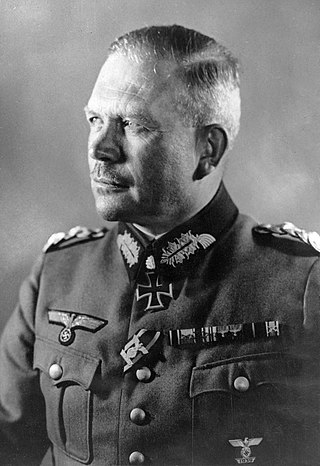
Heinz Wilhelm Guderian was a German general during World War II who, after the war, became a successful memoirist. An early pioneer and advocate of the "blitzkrieg" approach, he played a central role in the development of the panzer division concept. In 1936, he became the Inspector of Motorized Troops.

Georg Otto Hermann Balck was a highly decorated officer of the German Army who served in both World War I and World War II, rising to the rank of General der Panzertruppe.

Paul Ludwig Ewald von Kleist was a German Generalfeldmarschall of the Wehrmacht during World War II. Born into the Prussian noble family von Kleist, Kleist entered the Prussian Army in 1900 and commanded a cavalry squadron during World War I. Kleist joined the Reichswehr of inter-war Germany before being discharged in 1938.
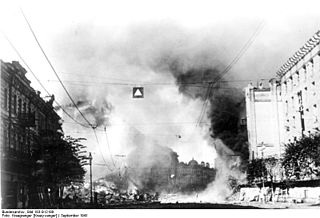
The First Battle of Kiev was the German name for the major battle that resulted in an encirclement of Soviet troops in the vicinity of Kiev during World War II, the capital and most populous city of the Ukrainian Soviet Socialist Republic. This encirclement is the largest encirclement in the history of warfare by number of troops. The battle occurred from 7 July to 26 September 1941 as part of Operation Barbarossa, the Axis invasion of the Soviet Union.

Fritz Hermann Michael Bayerlein was a Nazi German general in the Wehrmacht of during World War II. He initially served as a staff officer, including with Erwin Rommel in the Afrika Korps. He then commanded the 3rd Panzer Division, the Panzer Lehr Division and LIII Army Corps in the European theatre. Bayerlein was a recipient of the Knight's Cross of the Iron Cross with Oak Leaves and Swords.

A Panzer division was one of the armored (tank) divisions in the army of Nazi Germany during World War II. Panzer divisions were the key element of German success in the blitzkrieg operations of the early years of World War II. Later the Waffen-SS formed its own panzer divisions, and the Luftwaffe fielded an elite panzer division: the Hermann Göring Division.
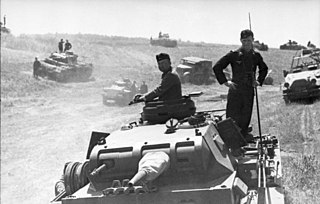
The 13th Panzer Division was a unit of the German Army during World War II, established in 1940.
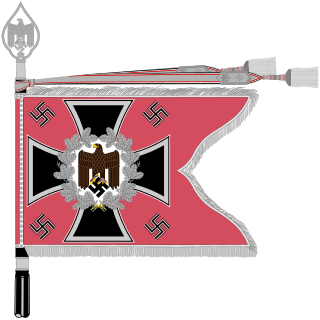
Panzerwaffe, later also Panzertruppe refers to a command within the Heer of the German Wehrmacht, responsible for the affairs of panzer (tank) and motorized forces shortly before and during the Second World War.
The XXXIX Panzer Corps was a German panzer corps which saw action on the Western and Eastern Fronts during World War II.

Friedrich Karl Albert Dollmann was a German general during World War II who commanded the 7th Army during the Invasion of France and the early phases of the Allied invasion of Normandy until his death in June 1944.

Ernst Volckheim was one of the founders of armored and mechanized warfare. A German officer in the First and Second World War, Volkheim rose to the rank of colonel, during World War II in the German Army. Little known outside of professional military and historical circles, Volckheim is considered the foremost military academic influence on German tank war proponent, Heinz Guderian, because both Volckheim's teaching as well as his 1924 professional military articles place him as one of the very earliest theorists of armored warfare and the use of German armored formations including independent tank corps.

The 268th Infantry Division was a German Army division active and operating during the Second World War.
Ernst Feßmann was a German general of the Heer who led the 267th Infantry Division in the early stages of World War II. Prior to the war, he was also notable for commanding one of the first Panzer Divisions.

Ludwig Kübler was a German General der Gebirgstruppe who commanded the 1st Mountain Division, XXXXIX Mountain Corps, 4th Army and the Operational Zone of the Adriatic Littoral during World War II. He was awarded the Knight's Cross of the Iron Cross for his actions commanding the 1st Mountain Division during the invasion of Poland in 1939. He also commanded the division during the invasion of France and the Low Countries before being appointed to command XXXXIX Mountain Corps. During his command of this corps it was involved in the invasion of Yugoslavia and the attack on the Soviet Union. In December 1941 he was appointed to command the 4th Army, but was dismissed from this post in January of the following year, and placed in the Führerreserve des Heeres. In September 1943 he was appointed as the commanding general of security troops for Army Group Centre on the Eastern Front, but the following month he was appointed to command the Operational Zone of the Adriatic Littoral, based at Trieste on the northern Adriatic coast. After being captured by Yugoslav forces at the end of the war, he was tried and executed for war crimes.

Eduard Crasemann was a German General der Artillerie in the Wehrmacht and convicted war criminal who commanded several Panzer divisions during World War II.
Eduard Hauser was a German general in the Wehrmacht during World War II who commanded the 13th Panzer Division. He was a recipient of the Knight's Cross of the Iron Cross with Oak Leaves.

Johannes Streich was a German general in the Wehrmacht during World War II who commanded the 5th Light Division during the early stages of the North African Campaign. Sacked for his poor performance during the Siege of Tobruk, he later briefly commanded the 16th Motorised Infantry Division during the advance on Moscow. A veteran of World War I, he was also a recipient of the Knight's Cross of the Iron Cross.
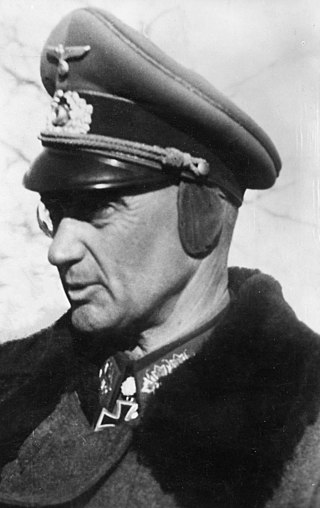
Otto Moritz Walter Model was a German Generalfeldmarschall during World War II. Although he was a hard-driving, aggressive panzer commander early in the war, Model became best known as a practitioner of defensive warfare. His relative success as commander of the Ninth Army in the battles of 1941–1942 determined his future career path.

Pavel Alexeyevich Belov was a Soviet Army colonel general and a Hero of the Soviet Union. He was nicknamed the "Fox" by the Germans and personally led the longest successful war raid, lasting five months behind the German lines. He has earned legendary status and could be considered one of the greatest cavalry generals. Considering his accomplishments from 1941-1945, his adaptation of combining horses, tanks, artillery, and aircraft on a modern battlefield resulted in the victory against a more technologically advanced enemy, often in the most desperate parts of the Eastern Front.
Heinrich von Prittwitz und Gaffron was a general officer in the Heer (Army) branch of the Wehrmacht of Nazi Germany during World War II. He was commander of the 14th and 15th Panzer Divisions and was killed in action in the early stages of the Siege of Tobruk.
















